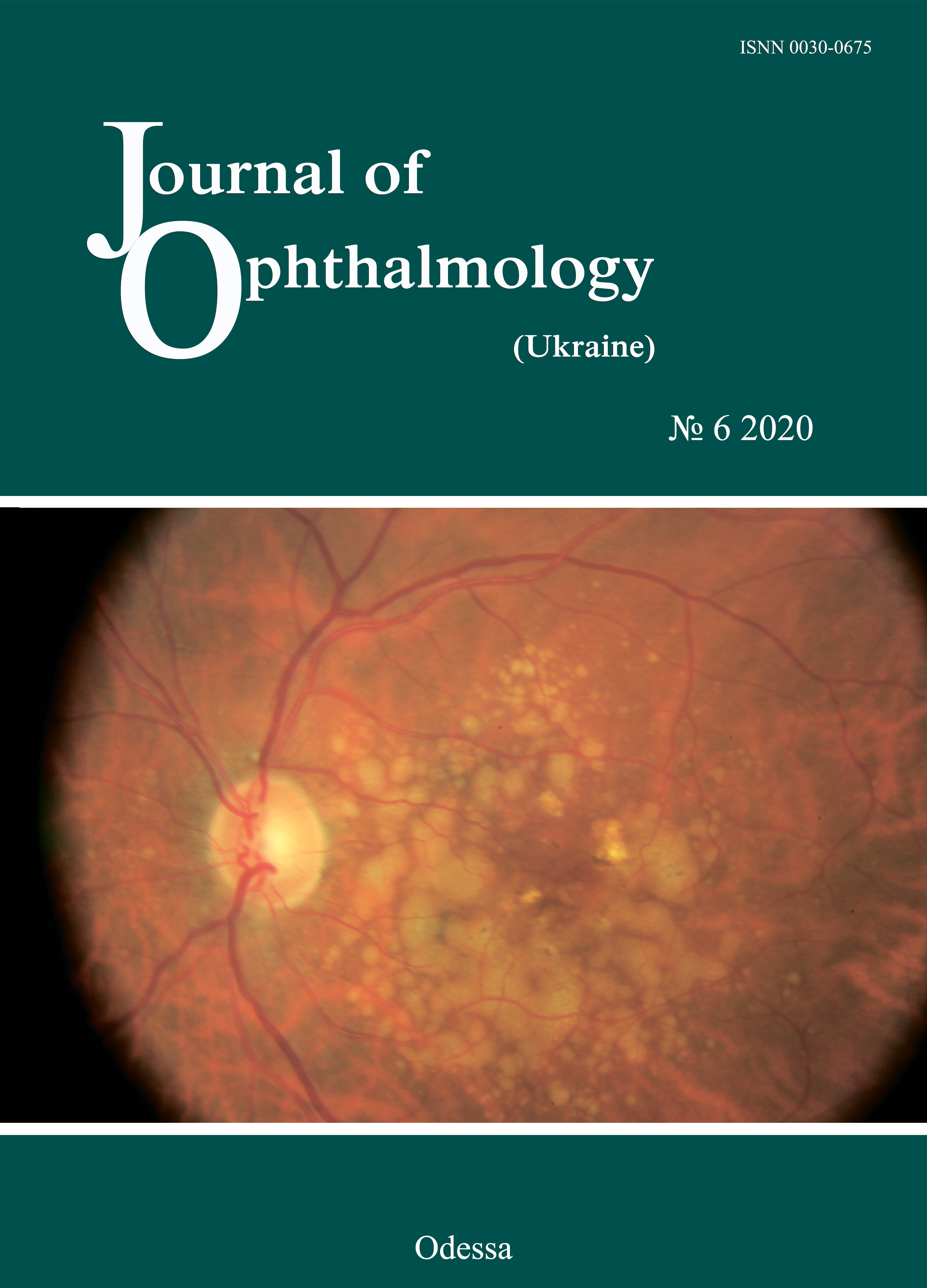Comparing detection rates of near-infrared transpalpebral transillumination, ultrasonography and radiography for foreign bodies in the anterior segment of the eye
DOI:
https://doi.org/10.31288/oftalmolzh202061924Keywords:
penetrating globe injury, intraocular foreign body, infrared radiation, transilluminationAbstract
Background: Penetrating globe injury is a leading cause of registered visual disability among working-age adults. Despite advances in imaging techniques, the detection of an intraocular foreign body (IOFB) in the projection of the ciliary body is still a challenge for the ophthalmologist.
Purpose: To compare detection rates of near-infrared transpalpebral transillumination, ultrasonography and radiography for foreign bodies situated in the anterior segment of the eye.
Material and Methods: Thirty male patients (30 eyes; age, 21 to 65 years) with penetrating globe injuries and suspected foreign body in the anterior segment of the eye (the anterior chamber, lens, anterior vitreous cavity) were under our observation. The fellow eye was unaffected. Patients underwent visual acuity assessment, biomicroscopy, ophthalmoscopy, ultrasound scanning of the anterior and posterior segment of the eye, ultrasound biometry, radiography and near-infrared transpalpebral transillumination (NIR TPT).
Results: The use of a non-invasive NIR TPT method in conjunction with traditional imaging modalities (radiography and ultrasound) resulted in a ten percent increase in the rate of detection of anterior segment foreign bodies due to the detection of some X-ray-negative IOFBs and identification of small (less than 1 mm) IOFBs.
Conclusion: The NIR TPT method allows for non-invasive visualization of anterior segment foreign bodies of various compositions in patients with penetrating globe injuries. The use of a non-invasive NIR TPT method in conjunction with traditional imaging modalities resulted in a ten percent increase in the rate of detection of foreign bodies due to the detection of some X-ray-negative IOFBs and identification of small (less than 1 mm) IOFBs. Massive subconjunctival hemorrhages hamper adequate detection of foreign bodies in the projection of the ciliary body by NIR TPT due to intensive absorption of near-infrared light.
References
1.Lima-Gómez V, Blanco-Hernández D, Rojas-Dosal J. Ocular trauma score at the initial evaluation of ocular trauma. Cir Cir. May-Jun 2010;78(3):209-13.
2.Loporchio D, Mukkamala L, Gorukanti K, Zarbin M, Langer P, Bhagat N. Intraocular foreign bodies. Surv Ophthalmol. 2016; 61(5):582-96. https://doi.org/10.1016/j.survophthal.2016.03.005
3.Zhang Y, Zhang M, Jiang C, Qiu HY. Intraocular foreign bodies in China: clinical characteristics, prognostic factors, and visual outcomes in 1,421 eyes. Am J Ophthalmol. 2011;152(1):66-73.https://doi.org/10.1016/j.ajo.2011.01.014
4.Kuhn F, Pieramici DJ. Intraocular foreign bodies, In: Ferenc K, Pieramici D (eds) Ocular Trauma: Principles and Practice. New York, Thieme; 2002, p. 235-63.https://doi.org/10.1055/b-002-51011
5.Potts AM, Distler JA. Shape factor in the penetration of intraocular foreign bodies. Am J Ophthalmol. 1985;100(1):183-7.https://doi.org/10.1016/S0002-9394(14)75003-2
6.Reynolds DS, Flynn HW, Jr. Endophthalmitis after penetrating ocular trauma. Curr Opin Ophthalmol. 1997; 8:32-38.https://doi.org/10.1097/00055735-199706000-00006
7.Arora R, Sanga L, Kumar M, Taneja M. Intralenticular foreign bodies: report of eight cases and review of management. Indian J Ophthalmol. 2000;48:119-22.
8.Lee W, Park SY, Park TK, Kim HK, Ohn YH. Mature cataract and lens-induced glaucoma associated with an asymptomatic intralenticular foreign body. J Cataract Refract Surg. 2007 Mar;33(3):550-2.https://doi.org/10.1016/j.jcrs.2006.09.043
9.Lin YC, Kuo CL, Chen YM. Intralenticular foreign body: A case report and literature review. Taiwan J Ophthalmol. 2019;9(1):53-59.https://doi.org/10.4103/tjo.tjo_88_18
10.Raina U, Kumar V, Kumar V, Sud R, Goel N, Ghosh B. Metallic intraocular foreign body retained for four years - an unusual presentation. Cont Lens Anterior Eye. 2010;33:202-4. https://doi.org/10.1016/j.clae.2010.01.005
11.Tokoro M, Yasukawa T, Okada M, Ogura Y, Uchida S. Copper foreign body in the lens without damage of iris and lens capsule. Int Ophthalmol. 2007;27(5):329-31. https://doi.org/10.1007/s10792-007-9074-5
12.Zadorozhnyy O, Alibet Yassine, Kryvoruchko A, Levytska G, Pasyechnikova N. Dimensions of ciliary body structures in various axial lengths in patients with rhegmatogenous retinal detachment. J Ophthalmol (Ukraine). 2017;6:32-6. https://doi.org/10.31288/oftalmolzh201763236
13.Zadorozhnyy O, Korol A, Nevska A, Kustryn T, Pasyechnikova N. Ciliary body imaging with transpalpebral near-infrared transillumination - a pilot study. Klinika oczna. 2016;3:184-6.
14.Kogan M, Zadorozhnyy O, Petretska O, Krasnovid T, Korol A, Pasyechnikova N. [Imaging of Intraocular Foreign Bodies Located in the Projection of the Ciliary Body by Infrared Transillumination (Pilot Study)]. Klin Monbl Augenheilkd. 2020; 237(07): 889-93. German. https://doi.org/10.1055/a-1142-6502
15.Kogan MB. Visualization of anterior eye structures by near-infrared transillumination in patients with contusions of the globe. J Ophthalmol (Ukraine). 2020;2:46-50.https://doi.org/10.31288/oftalmolzh202024549
16.Kogan MB, Zadorozhnyy OS, Petretska OS, Krasnovid TA, Korol AR, Pasyechnikova NV. Visualization of intraocular foreign bodies in the projection of the ciliary body by transpalpebral near-infrared transillumination. J Ophthalmol (Ukraine). 2019;4:23-27.https://doi.org/10.31288/oftalmolzh201942327
17.Zadorozhnyy O, Guzun O, Kustryn T, Nasinnyk I, Chechin P, Korol A. Targeted transscleral laser photocoagulation of the ciliary body in patients with neovascular glaucoma. J Ophthalmol (Ukraine). 2019;4:3-7.https://doi.org/10.31288/oftalmolzh2019437
18.Kanda Y. Investigation of the freely available easy-to-use software 'EZR' for medical statistics. Bone Marrow Transplant. 2013;48:452-458. https://doi.org/10.1038/bmt.2012.244
19.Coleman DJ, Lucas BC, Rondeau MJ, Chang S. Management of intraocular foreign bodies. Ophthalmology. 1987; 94: 1647-53.https://doi.org/10.1016/S0161-6420(87)33239-7
20.Erikitola O, Shahid S, Waqar S, Hewick S. Ocular trauma:classification, management and prognosis. Brit J Hosp Med. 2013;74:108-11.https://doi.org/10.12968/hmed.2013.74.Sup7.C108
21.Pandey A.N. Ocular Foreign Bodies: A Review. J Clin Exp Ophthalmol. 2017; 8:645.https://doi.org/10.4172/2155-9570.1000645
22.Navon SE. Management of the ruptured globe. Int Ophthalmol Clin. 1995;35:71-91.https://doi.org/10.1097/00004397-199503510-00009
Downloads
Published
How to Cite
Issue
Section
License
Copyright (c) 2025 М. Б. Коган, О. С. Задорожный, О. С. Петрецкая, Т. А. Красновид, А. Р. Король

This work is licensed under a Creative Commons Attribution 4.0 International License.
This work is licensed under a Creative Commons Attribution 4.0 International (CC BY 4.0) that allows users to read, download, copy, distribute, print, search, or link to the full texts of the articles, or use them for any other lawful purpose, without asking prior permission from the publisher or the author as long as they cite the source.
COPYRIGHT NOTICE
Authors who publish in this journal agree to the following terms:
- Authors hold copyright immediately after publication of their works and retain publishing rights without any restrictions.
- The copyright commencement date complies the publication date of the issue, where the article is included in.
DEPOSIT POLICY
- Authors are permitted and encouraged to post their work online (e.g., in institutional repositories or on their website) during the editorial process, as it can lead to productive exchanges, as well as earlier and greater citation of published work.
- Authors are able to enter into separate, additional contractual arrangements for the non-exclusive distribution of the journal's published version of the work with an acknowledgement of its initial publication in this journal.
- Post-print (post-refereeing manuscript version) and publisher's PDF-version self-archiving is allowed.
- Archiving the pre-print (pre-refereeing manuscript version) not allowed.












